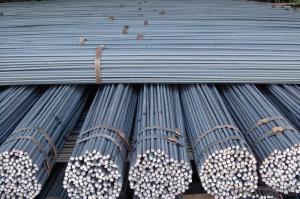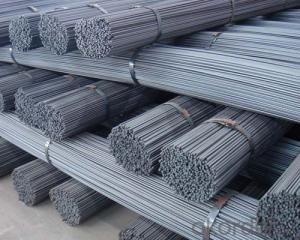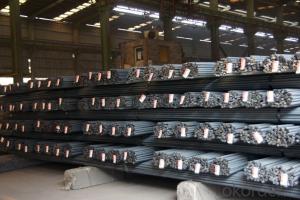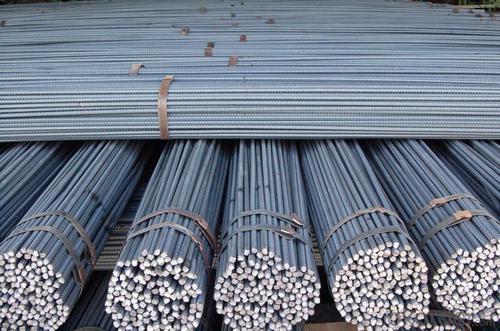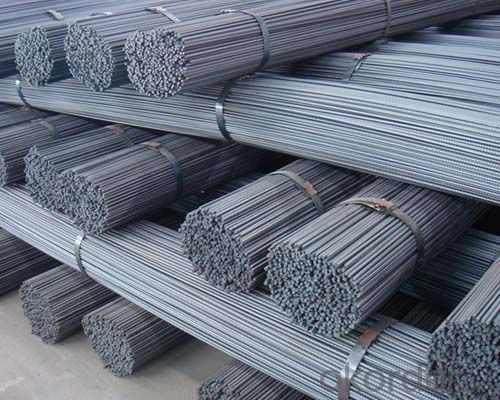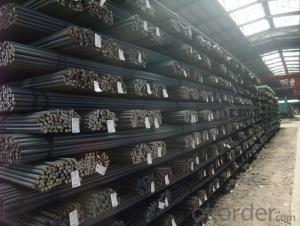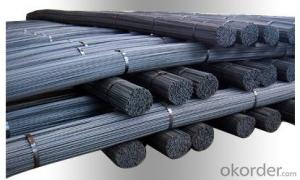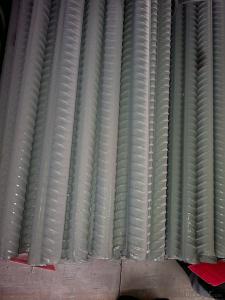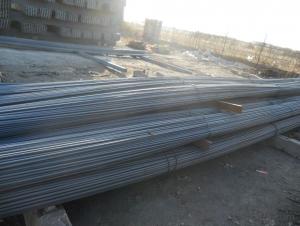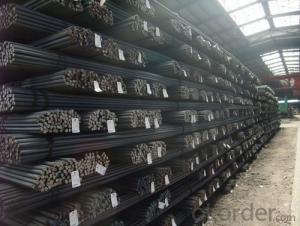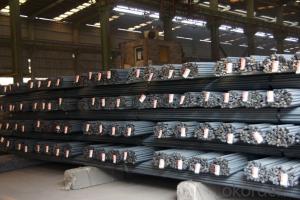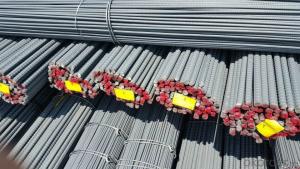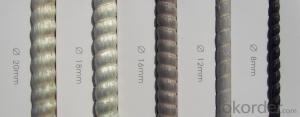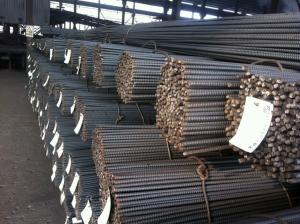HRB400 deformed bars with competitive price good quality
- Loading Port:
- Tianjin
- Payment Terms:
- TT OR LC
- Min Order Qty:
- 25 m.t.
- Supply Capability:
- 100000 m.t./month
OKorder Service Pledge
OKorder Financial Service
You Might Also Like
Product Description:
Specifications of HRB400 Deformed Steel Bar:
Standard | GB | HRB400 | |
Diameter | 10mm-32mm | ||
Length | 6M, 12M | ||
Place of origin | Hebei, China mainland | ||
Advantages | exact size, regular package, chemical and mechanical properties are stable. | ||
Type | Hot rolled deformed steel bar | ||
Chemical Composition: (Please kindly find our chemistry of our material based on HRB400 as below for your information)
Grade | Technical data of the original chemical composition (%) | ||||||
C | Mn | Si | S | P | V | ||
HRB400 | ≤0.25 | ≤1.60 | ≤0.80 | ≤0.045 | ≤0.045 | 0.04-0.12 | |
Physical capability | |||||||
Yield Strength (N/cm²) | Tensile Strength (N/cm²) | Elongation (%) | |||||
≥400 | ≥570 | ≥14 | |||||
Theoretical weight and section area of each diameter as below for your information:
Diameter(mm) | Section area (mm²) | Mass(kg/m) | Weight of 12m bar(kg) |
18 | 254.5 | 2.00 | 24 |
20 | 314.2 | 2.47 | 29.64 |
22 | 380.1 | 2.98 | 35.76 |
Usage and Applications of HRB400 Deformed Steel Bar:
Deformed bar is widely used in buildings, bridges, roads and other engineering construction. Big to highways, railways, bridges, culverts, tunnels, public facilities such as flood control, dam, small to housing construction, beam, column, wall and the foundation of the plate, deformed bar is an integral structure material. With the development of world economy and the vigorous development of infrastructure construction, real estate, the demand for deformed bar will be larger and larger..
Packaging & Delivery of HRB400 Deformed Steel Bar:
Packaging Detail: products are packed in bundle and then shipped by container or bulk vessel, deformed bar is usually naked strapping delivery, when storing, please pay attention to moisture proof. The performance of rust will produce adverse effect.
Each bundle weight: 2-3MT, or as required
Payment term: TT or L/C
Delivery Detail: within 45 days after received advanced payment or LC.
Label: to be specified by customer, generally, each bundle has 1-2 labels
Trade terms: FOB, CFR, CIF

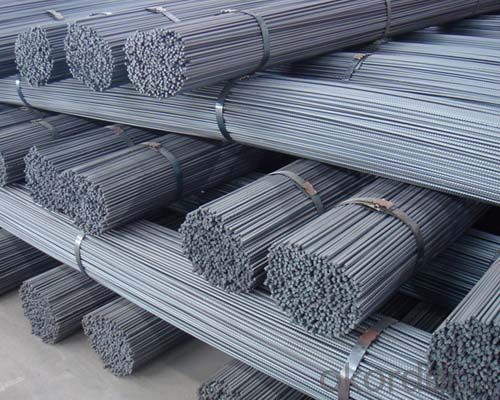
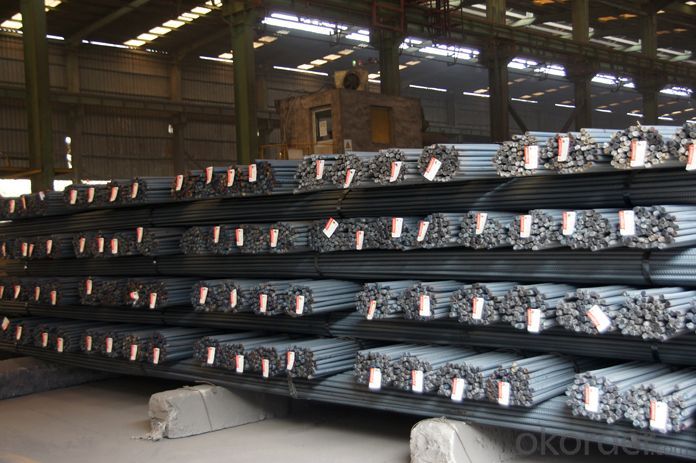
*If you would like to get our price, please inform us the size, standard/material and quantity. Thank you very much for your attention.
- Q: How do steel rebars contribute to the fire resistance of a structure?
- Steel rebars contribute to the fire resistance of a structure by providing reinforcement and stability to the concrete. In the event of a fire, steel rebars help to maintain the structural integrity of the building by preventing the concrete from cracking or collapsing. The high melting point of steel also allows it to retain its strength and structural integrity even at high temperatures, which helps to slow down the spread of fire and allow occupants to safely evacuate the building.
- Q: How are steel rebars used in the construction of airports?
- Steel rebars are used in the construction of airports to reinforce and strengthen concrete structures such as runways, taxiways, terminal buildings, and other infrastructure. These rebars are embedded within the concrete to provide tensile strength and prevent cracking, ensuring the structural integrity and durability of the airport facilities.
- Q: What are the different types of surface finishes available for steel rebars?
- Some of the different types of surface finishes available for steel rebars include black or plain, epoxy-coated, galvanized, and stainless steel.
- Q: Can steel rebars be used in the construction of data centers and server rooms?
- Yes, steel rebars can be used in the construction of data centers and server rooms. Steel rebars provide structural reinforcement and can be used in the construction of walls, columns, and foundations. They help to enhance the overall strength and durability of the building, ensuring the safety and stability of the data center or server room infrastructure.
- Q: How do steel rebars affect the overall thermal expansion of concrete structures?
- Steel rebars have a significant impact on the overall thermal expansion of concrete structures. Due to the difference in thermal expansion coefficients between steel and concrete, the rebars tend to expand and contract at a different rate compared to the surrounding concrete. This mismatch in thermal expansion can lead to internal stresses and potential cracking in the concrete. However, the presence of steel rebars also provides reinforcement and increases the tensile strength of the structure, which can help counteract these effects and enhance overall durability.
- Q: How do steel rebars perform in fire-resistant constructions?
- Due to their inherent properties, steel rebars are highly effective in fire-resistant constructions. The utilization of steel rebars in these structures serves to bolster their fire resistance. Steel possesses a high melting point and exhibits exceptional heat transfer properties, rendering it a dependable material in fire scenarios. When subjected to elevated temperatures, steel rebars do not undergo combustion or emit toxic fumes, crucially ensuring the safety of individuals during a fire incident. Furthermore, steel rebars possess a low coefficient of thermal expansion, signifying that they experience minimal expansion when exposed to heat. This characteristic helps to maintain the structural integrity of fire-resistant constructions, thereby averting potential structural failures during a fire. Additionally, steel rebars boast high tensile strength, which significantly contributes to the overall performance of the structure in fire conditions. This strength enables the rebars to withstand the forces generated by the concrete's expansion due to heat, thereby reducing the risk of cracking or spalling. Moreover, steel rebars can be encased in fire-resistant materials like concrete and fireproof coatings to provide an additional layer of protection against fire. This combination of steel and fire-resistant materials produces a robust system that effectively endures high temperatures and prolongs the construction's structural stability in the event of a fire. In conclusion, steel rebars play a vital role in fire-resistant constructions. Their high melting point, low thermal expansion, and exceptional tensile strength make them a dependable choice for enhancing the fire resistance of structures. By incorporating steel rebars into construction designs, the safety and durability of buildings are significantly enhanced, affording occupants valuable time to evacuate and minimizing the potential for structural damage during a fire incident.
- Q: What are the different grades of steel rebars used in bridge construction?
- The construction of bridges requires the use of different grades of steel rebars, which are selected based on the specific demands and load-bearing capacities of the structure. The following are the most frequently employed grades of steel rebars in bridge construction: 1. Grade 40: This is the lowest grade of steel rebar utilized in bridge construction. It possesses a minimum yield strength of 40,000 pounds per square inch (psi). Grade 40 steel rebars are typically employed for lighter loads and smaller bridge structures. 2. Grade 60: This is the grade of steel rebar most commonly used in bridge construction. It boasts a minimum yield strength of 60,000 psi. Grade 60 steel rebars are suitable for medium to heavy loads and are frequently employed in bridge piers, girders, and deck slabs. 3. Grade 75: This grade of steel rebar possesses a minimum yield strength of 75,000 psi. Grade 75 steel rebars are employed for heavy loads and large bridge structures that necessitate greater strength. They are commonly utilized in the construction of high-rise bridges and long-span structures. 4. Grade 80 and Grade 100: These are high-strength steel rebars with minimum yield strengths of 80,000 psi and 100,000 psi, respectively. These grades of steel rebars are used in specialized bridge construction projects that require exceptional strength and durability. They are commonly employed in the construction of cable-stayed bridges and suspension bridges. It is worth noting that the selection of the appropriate grade of steel rebar for bridge construction relies on various factors, including anticipated loads, span length, design specifications, and local building codes. Consulting with structural engineers and adhering to recommended guidelines ensures the utilization of the appropriate grade of steel rebar, thereby guaranteeing the safety and longevity of the bridge structure.
- Q: What is the process of pre-stressing steel rebars?
- Steel rebars undergo a process called pre-stressing, wherein a predetermined amount of stress or force is applied to them before they are loaded. This technique is widely employed in the construction industry to enhance the structural strength and durability of concrete structures. The process typically commences with the selection of high-strength steel rebars that possess favorable tensile strength properties. These rebars are commonly crafted from either carbon steel or alloy steel and come in various shapes and sizes, depending on the specific application. Once the rebars are chosen, they are cleaned and coated with a protective layer to prevent corrosion. Subsequently, they are positioned as per the design specifications within the concrete structure, such as beams, columns, or slabs. Next, the pre-stressing process is initiated, which involves two main methods: pre-tensioning and post-tensioning. In pre-tensioning, the rebars are initially tensioned by being fixed to an anchorage point or a sturdy frame. The opposite end of the rebars is then pulled using hydraulic jacks or mechanical devices, exerting a substantial amount of force. Once the desired stress is attained, the rebars are secured in their stressed position by casting concrete around them. After the concrete solidifies, the jacks or devices are released, transferring the stress to the rebars. In post-tensioning, the rebars are initially placed in the concrete structure without any tension. After the concrete solidifies, ducts or channels are created within the structure along the path of the rebars. High-strength steel strands or cables are then inserted through these ducts. The strands are anchored at one end of the structure and tensioned using hydraulic jacks or similar devices. This tensioning process applies a force to the rebars, which is transferred to the concrete, compressing it. Once the desired stress is achieved, the strands are secured and the ducts are filled with grout or mortar for corrosion protection. Both pre-tensioning and post-tensioning techniques yield pre-stressed steel rebars that offer several advantages to concrete structures. These include increased load-carrying capacity, improved resistance to cracking and deformation, enhanced durability, and overall superior structural performance. The process of pre-stressing steel rebars is an essential aspect of modern construction practices, guaranteeing the longevity and safety of various types of concrete structures.
- Q: Are steel rebars suitable for use in tunnels and underground mines?
- Tunnels and underground mines can benefit greatly from the use of steel rebars. These reinforcement bars, also called steel rebars, are commonly utilized in construction due to their strength and durability. In environments where structural integrity is crucial, such as tunnels and underground mines, steel rebars offer the necessary reinforcement to withstand the heavy loads and pressures associated with these settings. Steel rebars possess exceptional tensile strength, enabling them to resist bending and cracking even under high stress. This attribute is particularly important in tunnels and underground mines, where the surrounding rock and soil exert significant pressure on the structure. By reinforcing the concrete or other structural materials with steel rebars, the overall strength and stability of the tunnel or mine are enhanced, mitigating the risk of collapse or damage. Moreover, steel rebars exhibit resistance to corrosion, rendering them suitable for use in underground environments where moisture and chemical exposure are prevalent. Corrosion can weaken reinforcement materials, compromising the safety of the tunnel or mine. Conversely, steel rebars provide long-lasting reinforcement, ensuring the infrastructure's longevity and reliability. Additionally, steel rebars offer convenience in fabrication and installation, making them a practical choice for tunnel and underground mine construction. They can be easily cut and bent into specific shapes and sizes, facilitating customized reinforcement solutions tailored to the unique requirements of each project. This versatility and ease of installation make steel rebars an advantageous option for tunnels and underground mines, which often encounter complex geometries and challenging conditions. In conclusion, steel rebars are an ideal choice for tunnels and underground mines due to their strength, durability, corrosion resistance, and ease of installation. By utilizing steel rebars as reinforcement, these structures can be built to withstand demanding conditions, ensuring the safety of workers and the long-term viability of the infrastructure.
- Q: What is the role of steel rebars in industrial construction?
- Steel rebars play a crucial role in industrial construction as they provide reinforcement and support to concrete structures, enhancing their strength and durability. They help to withstand heavy loads, resist tension and compression forces, and prevent cracks and structural failures. Rebars also improve the overall stability and safety of buildings, making them essential components in industrial construction projects.
Send your message to us
HRB400 deformed bars with competitive price good quality
- Loading Port:
- Tianjin
- Payment Terms:
- TT OR LC
- Min Order Qty:
- 25 m.t.
- Supply Capability:
- 100000 m.t./month
OKorder Service Pledge
OKorder Financial Service
Similar products
Hot products
Hot Searches
Related keywords
